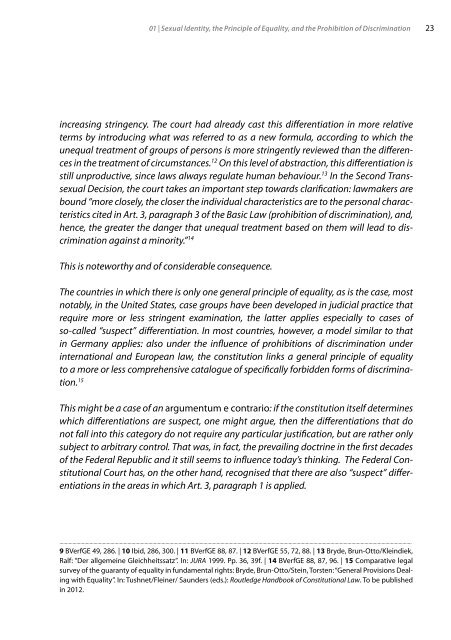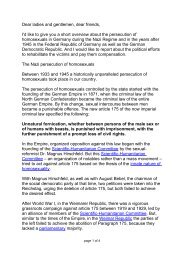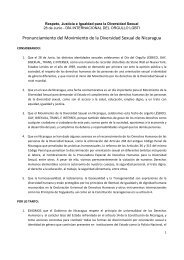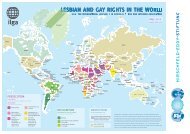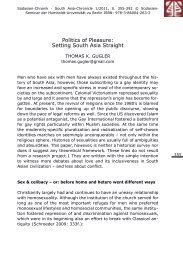Vom Verbot zur Gleichberechtigung - Hirschfeld-Eddy-Stiftung
Vom Verbot zur Gleichberechtigung - Hirschfeld-Eddy-Stiftung
Vom Verbot zur Gleichberechtigung - Hirschfeld-Eddy-Stiftung
Erfolgreiche ePaper selbst erstellen
Machen Sie aus Ihren PDF Publikationen ein blätterbares Flipbook mit unserer einzigartigen Google optimierten e-Paper Software.
01 | Sexual Identity, the Principle of Equality, and the Prohibition of Discrimination<br />
increasing stringency. The court had already cast this differentiation in more relative<br />
terms by introducing what was referred to as a new formula, according to which the<br />
unequal treatment of groups of persons is more stringently reviewed than the differen-<br />
ces in the treatment of circumstances. 12 On this level of abstraction, this differentiation is<br />
still unproductive, since laws always regulate human behaviour. 13 In the Second Transsexual<br />
Decision, the court takes an important step towards clarification: lawmakers are<br />
bound “more closely, the closer the individual characteristics are to the personal characteristics<br />
cited in Art. 3, paragraph 3 of the Basic Law (prohibition of discrimination), and,<br />
hence, the greater the danger that unequal treatment based on them will lead to discrimination<br />
against a minority.” 14<br />
This is noteworthy and of considerable consequence.<br />
The countries in which there is only one general principle of equality, as is the case, most<br />
notably, in the United States, case groups have been developed in judicial practice that<br />
require more or less stringent examination, the latter applies especially to cases of<br />
so-called “suspect” differentiation. In most countries, however, a model similar to that<br />
in Germany applies: also under the influence of prohibitions of discrimination under<br />
international and European law, the constitution links a general principle of equality<br />
to a more or less comprehensive catalogue of specifically forbidden forms of discrimination.<br />
15<br />
This might be a case of an argumentum e contrario: if the constitution itself determines<br />
which differentiations are suspect, one might argue, then the differentiations that do<br />
not fall into this category do not require any particular justification, but are rather only<br />
subject to arbitrary control. That was, in fact, the prevailing doctrine in the first decades<br />
of the Federal Republic and it still seems to influence today’s thinking. The Federal Constitutional<br />
Court has, on the other hand, recognised that there are also “suspect” differentiations<br />
in the areas in which Art. 3, paragraph 1 is applied.<br />
.............................................................................................................................................................................................................................................................................<br />
9 BVerfGE 49, 286. | 10 Ibid, 286, 300. | 11 BVerfGE 88, 87. | 12 BVerfGE 55, 72, 88. | 13 Bryde, Brun-Otto/Kleindiek,<br />
Ralf: “Der allgemeine Gleichheitssatz”. In: JURA 1999. Pp. 36, 39f. | 14 BVerfGE 88, 87, 96. | 15 Comparative legal<br />
survey of the guaranty of equality in fundamental rights: Bryde, Brun-Otto/Stein, Torsten: “General Provisions Dealing<br />
with Equality”. In: Tushnet/Fleiner/ Saunders (eds.): Routledge Handbook of Constitutional Law. To be published<br />
in 2012.<br />
23


